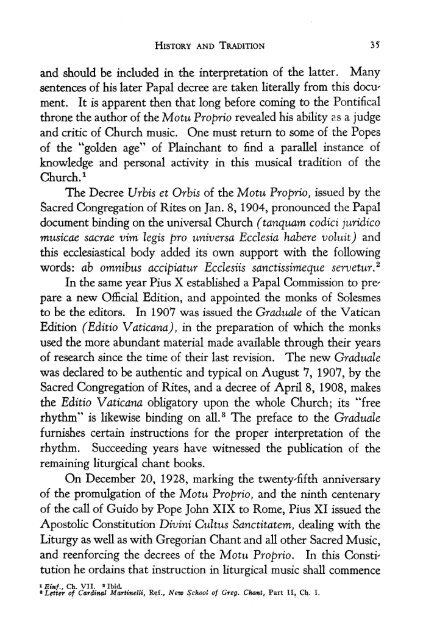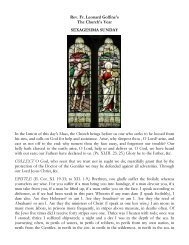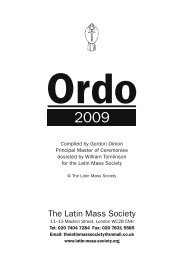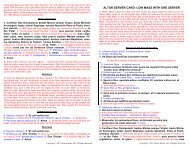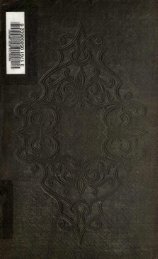The Spirit of Gregorian Chant - Church Music Association of America
The Spirit of Gregorian Chant - Church Music Association of America
The Spirit of Gregorian Chant - Church Music Association of America
Create successful ePaper yourself
Turn your PDF publications into a flip-book with our unique Google optimized e-Paper software.
HISTORY AND TRADITION 35<br />
and should be included in the interpretation <strong>of</strong> the latter. Many<br />
sentences <strong>of</strong> his later Papal decree are taken literally from this document.<br />
It is apparent then that long before coming to the Pontifical<br />
throne the author <strong>of</strong> the Motu Proprio revealed his ability as a judge<br />
and critic <strong>of</strong> <strong>Church</strong> music. One must return to some <strong>of</strong> the Popes<br />
<strong>of</strong> the "golden age" <strong>of</strong> Plainchant to find a parallel instance <strong>of</strong><br />
knowledge and personal activity in this musical tradition <strong>of</strong> the<br />
<strong>Church</strong>. 1<br />
<strong>The</strong> Decree Urbis et Orbis <strong>of</strong> the Motu Proprio, issued by the<br />
Sacred Congregation <strong>of</strong> Rites on Jan. 8, 1904, pronounced the Papal<br />
document binding on the universal <strong>Church</strong> (tanquam codici juridico<br />
musicae sacrae vim legis pro universa Ecclesia habere voluit) and<br />
this ecclesiastical body added its own support with the following<br />
words: ab omnibus accipiatur Ecclesiis sanctissimeque servetur. 2<br />
In the same year Pius X established a Papal Commission to prepare<br />
a new Official Edition, and appointed the monks <strong>of</strong> Solesmes<br />
to be the editors. In 1907 was issued the Graduate <strong>of</strong> the Vatican<br />
Edition (Editio Vaticana), in the preparation <strong>of</strong> which the monks<br />
used the more abundant material made available through their years<br />
<strong>of</strong> research since the time <strong>of</strong> their last revision. <strong>The</strong> new Graduale<br />
was declared to be authentic and typical on August 7, 1907, by the<br />
Sacred Congregation <strong>of</strong> Rites, and a decree <strong>of</strong> April 8, 1908, makes<br />
the Editio Vaticana obligatory upon the whole <strong>Church</strong>; its "free<br />
rhythm" is likewise binding on all. 3 <strong>The</strong> preface to the Graduale<br />
furnishes certain instructions for the proper interpretation <strong>of</strong> the<br />
rhythm. Succeeding years have witnessed the publication <strong>of</strong> the<br />
remaining liturgical chant books.<br />
On December 20, 1928, marking the twenty-fifth anniversary<br />
<strong>of</strong> the promulgation <strong>of</strong> the Motu Proprio, and the ninth centenary<br />
<strong>of</strong> the call <strong>of</strong> Guido by Pope John XIX to Rome, Pius XI issued the<br />
Apostolic Constitution Divini Cultus Sanctitatem, dealing with the<br />
Liturgy as well as with <strong>Gregorian</strong> <strong>Chant</strong> and all other Sacred <strong>Music</strong>,<br />
and reenforcing the decrees <strong>of</strong> the Motu Proprio. In this Constitution<br />
he ordains that instruction in liturgical music shall commence<br />
i Einf., Ch. VII.<br />
2 Ibid<br />
8 Letter <strong>of</strong> Cardinal Martinelli, Ref., New School <strong>of</strong> Greg. <strong>Chant</strong>, Part II, Ch. I.


